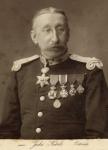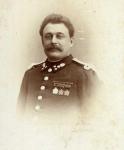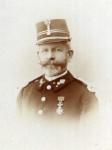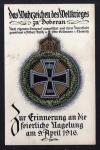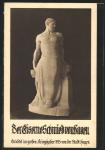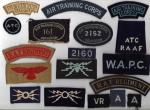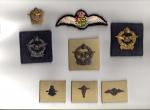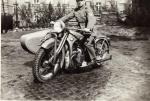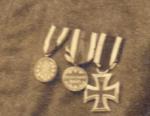-
Posts
2,143 -
Joined
-
Last visited
-
Days Won
10
Content Type
Profiles
Forums
Blogs
Gallery
Events
Store
Everything posted by Odulf
-
Indeed, Royal Danish Navy, engineers branch
-

Heer Tailor labels: Let's make a reference list here.
Odulf replied to azyeoman's topic in Wehrmacht Medals, Decorations & Awards
-

Please could I request further help
Odulf replied to wardyswife's topic in Great Britain: Research, Documentation & History
A very poor and blurred image. Would it be possible to take this CdV out of it's page and make a proper scan of both the front and back (preferably at 400+ dpi)? It is looks like a corporal, perhaps Royal Artillery, around 1880. But without more details it is impossible to make any better estimate. -

Belgium Belgian Garde Civique officer's bust
Odulf replied to Stuka f's topic in Northern European & Baltic States
I think that he is a Lieutenant of the Civil Guard (a Lt.Col. would have a crown and two pips). Significant for Civil Guardsmen are the typical shoulderboards, which are commonly called: "Mayonaise" -
Yep, and I am curious if any other certificates or tokes (pins, paper badges, post-cards, or such like) have been issued to similar nailings... I have found nothing about this with the dealers.... Have these (possible) tokens been rejected, ignored, been regarded unimportant and uncollectable? These are all tokens of history, to my opinion, but perhaps not to be regarded as "militaria"... Fact is, that about of some of these nailing-memorabilia postcards were produced, and some of these are very rare (and expensive).
-
I am afraid that the display will not help you, you'd better arrange to get an appointment with one of the backing crew and dive into the collection's store rooms. There are the details you seek.
-
These were made by many contractors, and there were slight differences over the time. Remember, that this type of SD cap was used for about half a century.....
-

Unknown (to me) side cap
Odulf replied to Tony's topic in Great Britain: Militaria: Badges, Uniforms & Equipment
US Army cap with British badge -
In all the nations at war, strong patriotic sentiments were promoted to fund the war. In this perspective, most governments sold War Bonds. But also the national Red Cross organizations and Christian or other welfare institutes were keen to collect money to fund their care for soldiers, sailors and civilians. This was done by the sale of postcards, street or house-to-house collections, fund raising manifestations etc. In Germany, a particular home front form of fundraising was called KRIEGSNAGELUNG, which is best translated as: Nails for the War. Participants could buy (symbolical) a nail which was hammered into an object, generally this was made of (German) oak and took the shape of an Iron Cross, a Warrior, a Shield with a crest or a Column. The benefits were funding the Kriegsopferwerk, the care for the German victims of war such as invalids, casualties and their families. Interesting to note, it that also communities of Germans and Austrians in the USA put up similar projects; an Iron Cross was nailed in San Francisco and a Shield with German Eagle in Baltimore. In Kiel (where at the well-known Germania Werft many U-Boats were built) the Vaterländische Frauen-Verein (Patriotic Women’s Society) and the Red Cross put up a huge wooden U-Boat to be “nailed”, starting from 22 September 1915. Obviously, spenders received a small paper scroll (13 x 17 cm), an Urkunde, to certificate their patriotism. For those of you who understand German, this may be an interesting article: http://de.wikipedia.org/wiki/Kriegsnagelungen From my collection, the Kiel document and a postcard of the U-Boat
-
According to the same book, the clasp must have been produced after 1918.
-
You are right Bison
-
According to "La Médaille coloniale - Guide du collectionneur" by Patric Binet (p.131), this particular type of casp for TONKIN was produced by Ferdinand Rottarch
-
Indeed Martin, pre 1919, as from that year the black-white-black Kokarde (roundel) was replaced by the gilted oval shield with the black eagle of the Weimar Republic (please note http://gmic.co.uk/index.php/topic/62702-reichsmarine-cap-tallies/) . The tally is to be found in the magnificent complete study of Bernd Wedeking & Markus Bodeux "Die Mützenbänder der Deutschen Marine - 1815-1918", 1st Edition 2005 ISBN 3 86619 000 X
-
Agree, Luftschutzpolizei Before, I have said some words about gathering information. To some this means: splashing all their needs of information on a forum, without doing any previous research and investing into a reference library. But I also realise that good books are not known to any one because there are so many titles (for better and worse) that is is difficult to decide what book to buy. In this particular case, I would advertise a book that I keep in my library at hand (see below). The only problem to some is, it is in German, but with a dictionary and a bit of effort you will find that you have a treasue trove at hand. Title: Deutsche Polizei-Uniformen 1936-1945 Author: Dieter Deuster Editor: Motor Buch Verlag Year: 2009
-

EK 1914 The EK1 in wear...
Odulf replied to Chris Boonzaier's topic in Germany: All Eras: The Iron Cross
Thanks Hardy, I've learned something -

EK 1914 The EK1 in wear...
Odulf replied to Chris Boonzaier's topic in Germany: All Eras: The Iron Cross
-
Recently I picked up this interesting CdV portrait, from a photograpic studio in (Hamburg) Altona. It is an Unteroffizier of the Hanseatic Infantry Regt. Nr.76. Interesting, because on the reverse of the card is not, as usual, the name and address of the photographer but a bird's view over the Regimental Barracks. Also interesting to note is the special Kokarde, with the Hanseatic Cross (Red on white), not to be mixed up with the Landwehr cross. To illustrate, two CdV portraits:
-

EK 1914 The EK1 in wear...
Odulf replied to Chris Boonzaier's topic in Germany: All Eras: The Iron Cross
Unidentified Gefreiter from Sachsen with the Friedrich-August Medals in Silver and Bronze, and the EK2 (1914), CdV portrait dating about 1918. -

Silver War Badge - Copy?
Odulf replied to paul kennedy's topic in Great Britain: Militaria: Badges, Uniforms & Equipment
It looks OK to me, also because I am not aware that any copies are in circulation.




